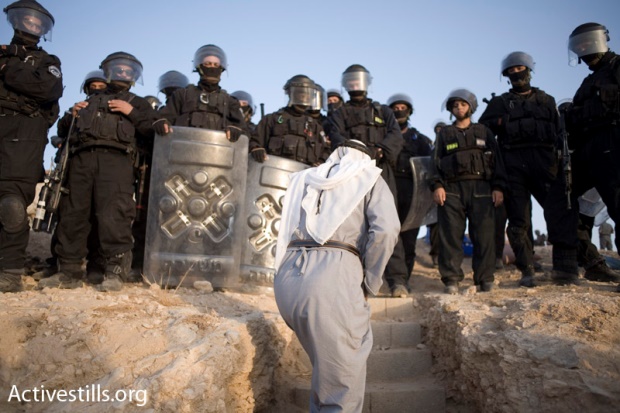The Prawer-Begin Plan is not the first time the state has displaced Bedouins in the Naqab (Negev). But it is a sign of how, 65 years after the state’s establishment, Israel still treats thousands of its Palestinian citizens no differently than those in the territories.

On April 25, a bus carrying Bedouin residents of Al-Araqib drove from the Naqab (Negev) in Israel to the Palestinian village of Susiya in the West Bank. The people were meeting for the first time to watch a screening of a new film by Adalah (the Legal Center for Arab Minority Rights in Israel), documenting the two villages’ stories of eviction and violence by Israeli authorities and Jewish civilians.
Al-Araqib and Susiya epitomize the injustice experienced by thousands of Palestinian Arabs both inside Israel and the occupied West Bank. Although they live on opposite sides of the border, the two villages are targets of the same Israeli policy of forced displacement. The destruction of homes, police and settler violence, and denial of basic services are all employed by the state to drive these villagers off their land.
Even in Israel proper, the legal structures that are supposed to defend Arab citizens from such discrimination are erased by the state’s belief that Arab rights can be violated at any time in order to maintain superior rights for Jews. Because of this ideology, the displacement of Palestinians is carried out with no regard for citizenship or human rights on either side of the border – as if the Green Line does not exist.
The last week alone has shown that this practice is pervasive and continuing. Political parties in the Israeli government are eagerly preparing their plans to demolish unrecognized Bedouin villages in the Naqab as harshly as possible. The Jaradat family in Jerusalem lost their homes to Israeli bulldozers after years of the municipality rejecting their requests for permits. The Adei Ad outpost demonstrated the creeping dispossession and theft of occupied lands and their damage to Palestinian livelihoods. Israeli citizenship, Jerusalemite status and Palestinian residency failed to protect these Arabs from the same discriminatory policy.
All this is happening while Jewish communities – both in Israel and the West Bank – are given the resources and legal recognition to expand as they please. In the Naqab, the Bedouin village of Umm el-Hieran will be demolished and emptied of inhabitants in order to build a new Jewish town called “Hiran” right over its ruins. In Sheikh Jarrah in East Jerusalem, police drag Arab families out of their homes while Jewish settlers enter in their place. In the Jordan Valley, Palestinians are cut off from water and agricultural lands as Israel builds networks of Jewish settlements, military zones and “nature reserves.”
The severity of forced displacement is plain for all to see. But like with many discriminatory laws and practices, the majority of the Israeli population is either ignorant or indifferent to the massive scale of displacement, while others support the policy due to racist misconceptions or beliefs. Despite the efforts of human rights groups to challenge the destruction of Arab communities on both sides of the Green Line, the Israeli courts have been complicit in allowing the policy to continue. All this worsens the lack of accountability for the state’s actions, and erodes any faith left for Israeli law to defend equal and human rights for non-Jews.
What is more alarming is that the policy is set to intensify over the coming years. On May 6, the government approved the latest draft of the Prawer-Begin Plan, which could see up to 70,000 Bedouin citizens forcibly relocated to underfunded and already-overcrowded “townships” in less than one percent of the Naqab’s land. Despite attempts to disguise the Plan as beneficial for the Bedouins, it aims to concentrate Arab communities in as little territory as possible and erase the Bedouins’ claims to their historical lands. Jewish citizens, of course, will continue to build new residences without such fears.
The Prawer-Begin Plan is not the first time the state has displaced Bedouins in the Naqab. But it is a sign of how, 65 years after the state’s establishment, Israel still treats thousands of its Palestinian citizens no differently than those in the occupied territories. The racist ideology that drives forced displacement has weakened the value of citizenship and erased the relevance of the Green Line; and it is that ideology that must be confronted in order to counter the ongoing discrimination faced by Palestinians. There may not yet be one state between the river and the sea, but observers cannot abide by the idea that Israel’s Arab minority, namely its Bedouin citizens, are protected by being on the Israeli side of the border. As a resident of Al-Araqib said after the screening in Susiya, “If my Israeli ID doesn’t give me my rights or protect my land, what use is it to me?”
Amjad Iraqi is an International Advocacy intern at Adalah – The Legal Center for Arab Minority Rights in Israel. He is a graduate of the Peace and Conflict Studies program at the University of Toronto. The opinions in this article are solely the author’s and do not represent the views of Adalah or +972 Magazine.
Read More:
Israeli coalition parties join forces to reduce land allocated to Bedouin
Resource: The Arab Bedouin of the Naqab – Myths and Misconceptions
Bedouin village in Negev to be destroyed, Jewish settlement to be built on site
WATCH: Jewish settlers await destruction of Bedouin village in Negev
Photo essay: Al-Araqib Bedouin’s ongoing struggle for their land

